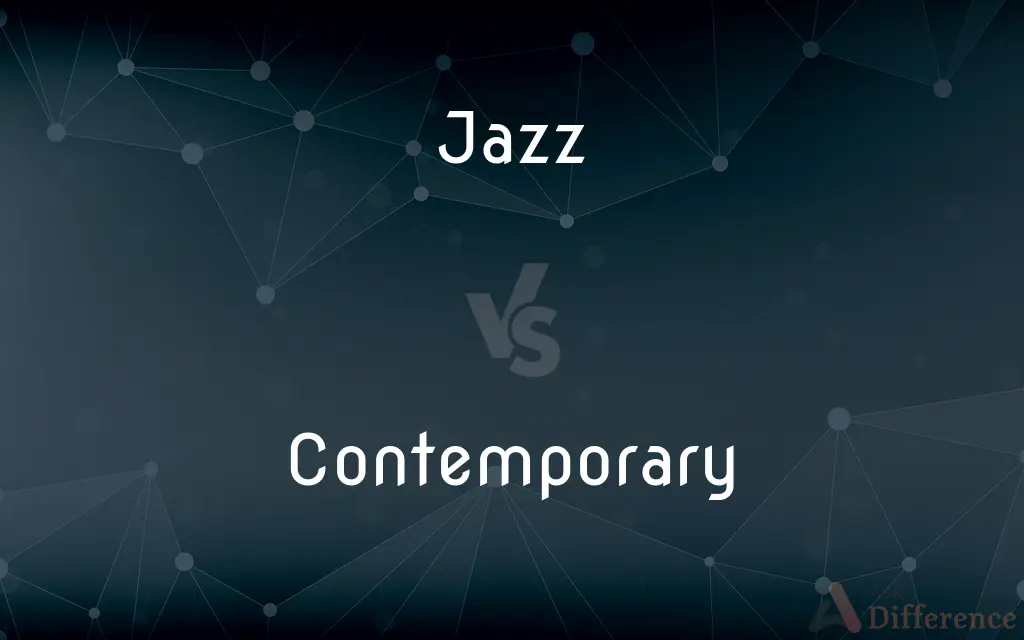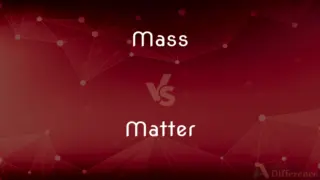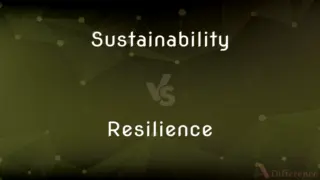Jazz vs. Contemporary — What's the Difference?
Edited by Tayyaba Rehman — By Urooj Arif — Updated on May 8, 2024
Jazz is a traditional dance form rooted in African-American culture with syncopated rhythms and improvisation, while contemporary dance blends various styles with a focus on fluid movement and storytelling.

Difference Between Jazz and Contemporary
Table of Contents
ADVERTISEMENT
Key Differences
Jazz dance is characterized by upbeat rhythms, sharp movements, and improvisation, tracing its roots back to African-American dance traditions. Contemporary dance, in contrast, merges elements from multiple genres like ballet, jazz, and modern dance while emphasizing fluidity and emotional expression.
Jazz dance often uses traditional jazz music or modern, upbeat tracks to drive its energetic movements. Meanwhile, contemporary dance employs a wide range of music, from classical to electronic, creating a versatile backdrop for storytelling and interpretation.
Jazz dancers typically use structured techniques and signature moves like kicks and turns to deliver dynamic choreography. On the other hand, contemporary dancers rely on fluid movement, often incorporating floor work and exploring space creatively.
Jazz dance prioritizes high energy and syncopated rhythms that require precise timing and body control. Contemporary dance, by contrast, prioritizes fluidity and freedom of movement, allowing dancers to experiment with unconventional shapes and timing.
Jazz is traditionally seen in Broadway performances and musical theater. Contemporary dance is more often seen in artistic showcases and dance competitions, where creative choreography and storytelling take center stage.
ADVERTISEMENT
Comparison Chart
Music
Jazz, swing, and upbeat tracks
Classical, electronic, varied
Movement Style
Sharp, syncopated, energetic
Fluid, experimental, expressive
Choreography Focus
Structured, dynamic moves
Creative, story-driven
Typical Venue
Broadway, musicals, studios
Art showcases, competitions
Techniques
Kicks, leaps, isolations, turns
Floor work, unconventional shapes
Compare with Definitions
Jazz
A dance form with roots in African-American culture.
The students practiced jazz dance routines for their recital.
Contemporary
A modern dance style blending ballet, jazz, and other forms.
The contemporary piece showcased a fusion of dance styles.
Jazz
Popularized in Broadway and musical theater productions.
The jazz number stole the show at the musical theater performance.
Contemporary
Incorporates a variety of music genres for diverse interpretations.
The contemporary choreography blended electronic music and classical scores.
Jazz
Often accompanied by upbeat, swing, or big band music.
The lively jazz soundtrack kept the dancers in high spirits.
Contemporary
Prioritizes storytelling and artistic exploration over rigid technique.
The contemporary piece emphasized creative exploration rather than strict technique.
Jazz
Known for syncopated rhythms and high-energy moves.
Jazz choreography often includes kicks, turns, and isolations.
Contemporary
Focuses on fluid movement and emotional expression.
Contemporary dancers use fluid, expressive choreography to tell stories.
Jazz
Emphasizes precise timing and sharp body movements.
The dancers maintained the rhythmic precision typical of jazz routines.
Contemporary
Allows for creative experimentation with unconventional shapes.
Contemporary dance embraces floor work and abstract movement.
Jazz
Jazz is a music genre that originated in the African-American communities of New Orleans, Louisiana, United States, in the late 19th and early 20th centuries, with its roots in blues and ragtime. Since the 1920s Jazz Age, it has been recognized as a major form of musical expression in traditional and popular music, linked by the common bonds of African-American and European-American musical parentage.
Contemporary
Living or occurring at the same time
The event was recorded by a contemporary historian
Jazz
A style of music, native to America, characterized by a strong but flexible rhythmic understructure with solo and ensemble improvisations on basic tunes and chord patterns and, more recently, a highly sophisticated harmonic idiom.
Contemporary
Belonging to or occurring in the present
The tension and complexities of our contemporary society
Jazz
Big band dance music.
Contemporary
A person or thing living or existing at the same time as another
He was a contemporary of Darwin
Jazz
Animation; enthusiasm.
Contemporary
Belonging to the same period of time
A fact documented by two contemporary sources.
Jazz
Nonsense.
Contemporary
Of about the same age.
Jazz
Miscellaneous, unspecified things
Brought the food and all the jazz to go with it.
Contemporary
Current; modern
Contemporary trends in design.
Jazz
(Music) To play in a jazz style.
Contemporary
One of the same time or age
Shelley and Keats were contemporaries.
Jazz
To utter exaggerations or lies to
Don't jazz me.
Contemporary
A person of the present age.
Jazz
To give great pleasure to; excite
The surprise party jazzed the guest of honor.
Contemporary
From the same time period, coexistent in time; contemporaneous.
Jazz
To cause to accelerate.
Contemporary
Modern, of the present age (shorthand for ‘contemporary with the present’).
Jazz
To exaggerate or lie.
Contemporary
Someone or something living at the same time, or of roughly the same age as another.
Cervantes was a contemporary of Shakespeare.
The early mammals inherited the earth by surviving their saurian contemporaries.
Jazz
(music genre) A musical art form rooted in West African cultural and musical expression and in the African American blues tradition, with diverse influences over time, commonly characterized by blue notes, syncopation, swing, call and response, polyrhythms and improvisation.
Contemporary
Something existing at the same time.
Jazz
Energy, excitement, excitability.
Contemporary
(dated) A rival newspaper or magazine.
Jazz
The substance or makeup of a thing.
What jazz were you referring to earlier?
What is all this jazz lying around?
Contemporary
Living, occuring, or existing, at the same time; done in, or belonging to, the same times; contemporaneous.
This king [Henry VIII.] was contemporary with the greatest monarchs of Europe.
Jazz
Unspecified thing(s).
Contemporary
Of the same age; coeval.
A grove born with himself he sees,And loves his old contemporary trees.
Jazz
(with positive terms) Something of excellent quality, the genuine article.
Contemporary
One who lives at the same time with another; as, Petrarch and Chaucer were contemporaries.
Jazz
Nonsense.
Stop talking jazz.
Contemporary
A person of nearly the same age as another.
Jazz
Semen, jizz.
Contemporary
A person of nearly the same age as another
Jazz
To destroy.
Contemporary
Characteristic of the present;
Contemporary trends in design
The role of computers in modern-day medicine
Jazz
To play (jazz music).
Contemporary
Belonging to the present time;
Contemporary leaders
Jazz
To dance to the tunes of jazz music.
Contemporary
Occurring in the same period of time;
A rise in interest rates is often contemporaneous with an increase in inflation
The composer Salieri was contemporary with Mozart
Jazz
To enliven, brighten up, make more colourful or exciting; excite
Jazz
To complicate.
Jazz
(intransitive) To move (around/about) in a lively or frivolous manner; to fool around.
Jazz
To distract or pester.
Jazz
To ejaculate.
Jazz
A type of music that originated in New Orleans around 1900 and developed through increasingly complex styles, but generally featuring intricate rhythms, improvisation, prominent solo segments, and great freedom in harmonic idiom played frequently in a polyphonic style, on various instruments including horn, saxophone, piano and percussion, but rarely stringed instruments.
Jazz
Empty or insincere or exaggerated talk; as, don't give me any of that jazz.
Jazz
A style of dance music popular in the 1920s; similar to New Orleans jazz but played by large bands.
Jazz
Empty rhetoric or insincere or exaggerated talk;
That's a lot of wind
Don't give me any of that jazz
Jazz
A genre of popular music that originated in New Orleans around 1900 and developed through increasingly complex styles
Jazz
A style of dance music popular in the 1920s; similar to New Orleans jazz but played by large bands
Jazz
Play something in the style of jazz
Common Curiosities
Where are jazz and contemporary dances commonly performed?
Jazz is often seen in Broadway and musical theater, while contemporary is showcased in artistic showcases and dance competitions.
How does choreography differ between jazz and contemporary dance?
Jazz choreography is structured with sharp movements and energetic steps, whereas contemporary choreography is fluid and story-driven.
Can jazz and contemporary dance styles be fused together?
Yes, many dance pieces combine elements from both styles for dynamic and expressive choreography.
Is there a difference in the focus of each dance form?
Jazz focuses on rhythm, precision, and dynamic movements, while contemporary emphasizes expression and creative exploration.
What distinguishes jazz dance from contemporary dance in terms of music?
Jazz dance often uses upbeat jazz or swing tracks, while contemporary dance explores a wide range of musical genres.
What makes contemporary dance choreography unique?
Contemporary dance uniquely explores unconventional shapes, floor work, and creative use of space.
How do jazz and contemporary dance differ in terms of energy?
Jazz is high-energy and rhythmically driven, while contemporary is often more nuanced and expressive in energy.
Do jazz and contemporary dancers require different training backgrounds?
Jazz dancers benefit from strong technical training, while contemporary dancers often have diverse backgrounds in ballet, modern, and jazz.
Which dance form is more structured in its choreography?
Jazz dance is more structured, while contemporary dance allows for more freedom and interpretation.
Are there specific training techniques unique to jazz dance?
Yes, jazz dancers focus on isolations, syncopated rhythms, and precise body movements.
Do contemporary dancers require specific footwear?
Contemporary dancers often dance barefoot to connect better with the floor and enhance movement expression.
What are some common moves in jazz dance?
Jazz dance features moves like kicks, leaps, isolations, and turns.
What role does improvisation play in jazz and contemporary dance?
Both dance forms use improvisation, but it's more ingrained in jazz, whereas contemporary incorporates it into storytelling.
Is there a specific movement style unique to contemporary dance?
Contemporary dance often incorporates fluid floor work and unconventional shapes that aren't seen in other dance styles.
Why is jazz dance often associated with musical theater?
Jazz dance's dynamic and precise movements complement musical theater performances.
Share Your Discovery

Previous Comparison
Mass vs. Matter
Next Comparison
Sustainability vs. ResilienceAuthor Spotlight
Written by
Urooj ArifUrooj is a skilled content writer at Ask Difference, known for her exceptional ability to simplify complex topics into engaging and informative content. With a passion for research and a flair for clear, concise writing, she consistently delivers articles that resonate with our diverse audience.
Edited by
Tayyaba RehmanTayyaba Rehman is a distinguished writer, currently serving as a primary contributor to askdifference.com. As a researcher in semantics and etymology, Tayyaba's passion for the complexity of languages and their distinctions has found a perfect home on the platform. Tayyaba delves into the intricacies of language, distinguishing between commonly confused words and phrases, thereby providing clarity for readers worldwide.













































